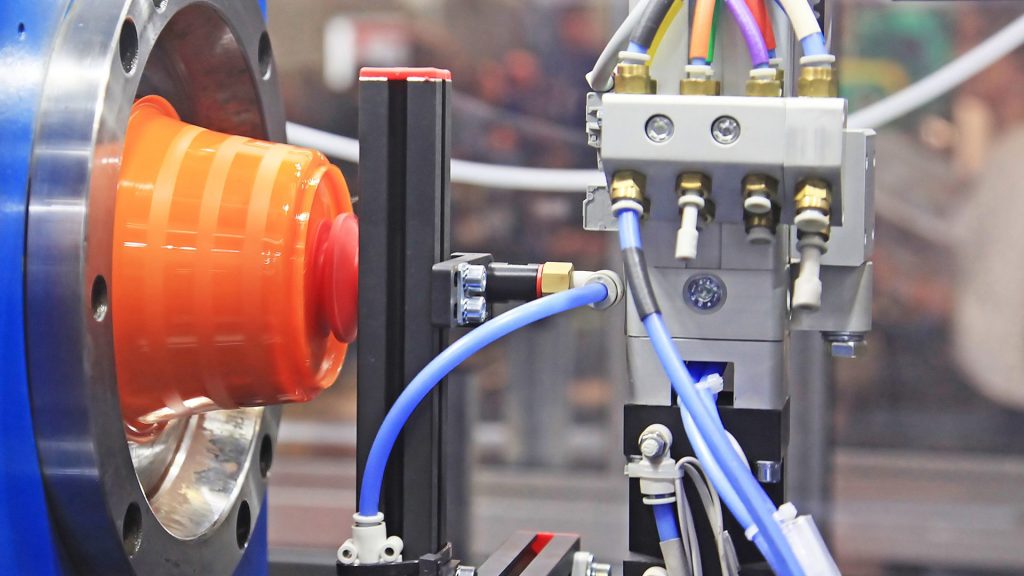Humidification Applications
Optimal humidity levels can increase production rates, improve product quality, avoid damaging static buildup,
and increase production efficiencies by keeping workers safe and comfortable. There’s a multitude of industrial
scenarios where humidification can help. Let MicroCool customize a solution for your unique application.

Clean Rooms
Certain production facilities and labs require above-average cleanliness. These industrial environments cannot tolerate significant amounts of dust and debris, and have very tight tolerance for humidity levels.
Those working in laboratories require constant, accurate atmospheric conditions with precise control for comparable, uniform results. Temperature and humidity are two key factors in the viscosity and usefulness of materials, as well as the speed of chemical reactions and other factors that may affect results. These climatic conditions also keep germs and other biological pollutants at bay.
Working in laboratories and other clean rooms requires a comfortable environment with a relative humidity of 40–60%, which encourages productivity while reducing worker health issues.
We can design air treatment systems for such locations using exclusive MicroCool nozzles that close after every operation, eliminating drips and drainage. Reverse Osmosis (RO) filtration system removes many types of large molecules and ions from the water supply including bacteria, pollen, and chemicals.

Food & Beverage
Maintaining proper humidity levels is essential in a wide variety of food and beverage industries, especially in cheese aging and the bread proofing processes. Typical cheese aging caves are kept at a 75°+ relative humidity range depending on whether the cheese is soft or hard rind. The aging process is crucial to developing the unique characteristics of the cheese’s flavor, texture and aroma. In bread making, the stage known as proofing requires a consistent level of humidity in a warm room environment so that when yeast is added, the dough ferments and rises to the desired levels. High moisture levels during dough fermentation prevent skin formation and promote yeast dough activation. Also, controlling humidity levels during the food packaging process is important so that label inks or wraps do not fail to adhere to the end product.
Another case in point is the making of other baked goods. The finest outcomes in commercially produced goods are obtained when numerous humidity levels are used throughout the manufacturing and storage process. In result of a proper humidification system, produce and ingredients will maintain moisture content and this additional weight will help drive more profit.
The moisture level of the oven has an impact on the consistency of the pie, cookies, rolls, cakes, or other baked goods during baking. For example, raising the humidity in the final few minutes of baking provides for a crispy, glossy surface on bread and rolls.
In the end, you are also able to preserve inventory and keep the building materials safe with proper humidification.

Hatcheries
Humidification levels in the hatchery industry significantly impact the process and the final product quality. At the egg stage, insufficient humidity levels can affect shell strength and density, and resultant birth rates and maturity. These are among the growing concerns in this industry. Once eggs have hatched, maintaining the ideal humidity helps the chicks through initial stages of growth before being moved to other facilities.
Most hatcheries consist of many different rooms and processes of varying sizes and humidity requirements. With a MicroCool System, zone sectioning controllers at each location are monitored from external units, or as part of the overall climate control system. Controllers feature the MicroCool DCS (Drain Control System), uniquely designed to reduce shock and vibration.
Indoor Spaces
Maintaining expert-specified humidity levels in an internal atmosphere contributes to the health of human-occupied spaces. Adding humidity keeps respiratory systems and mucous membranes from drying out. This plays a key role in the first line of defense against respiratory viral transmission. 40–60% humidity also helps to minimize viral transmission through exhaled respiratory droplets by containing and tackling them to the ground.
Manufacturing
There are as many different manufacturing processes as there are products being made – and every one of them benefits from having ideal industrial environments. It could be a high-tech manufacturer reducing static electricity, a medical manufacturer controlling dust, a woodworking operation maintaining stable humidity to reduce distortion, an automotive manufacturing industry in need of a reduced Electrostatic Discharge (ESD) Risk, or myriad other process requirements.
MicroCool has a solution for every one of them – bringing ease of operation, exacting control, cost-efficiency, and reliability to every factory floor and the entire manufacturing environment. Our experienced planners can custom design the ideal industrial humidification systems for your application.
In the long run, this leads to production efficiencies and higher product quality for your industry, thanks to correct humidity in all your manufacturing processes.

Plastics and Composites
Static can be minimized by humidifying indoor environments. Plastics in particular are often plagued by static in a production environment. Additionally, humidity plays a key role in maintaining shape and form of composite materials that can stick to machines, fall apart, or lose their shape. All of these issues can be helped with MicroCool humidifiers.
Friction is a common issue in low humidity production environments. This causes materials to become electrically charged, posing a risk of equipment damage and production shut-down. Air humidity is an important factor in the plastics sector since humidified air reduces static charges, plus it binds dust particles significantly better than dry air. Dust buildups on vital components and surfaces can lead to a higher failure rate, as well as quality assurance problems. A precise and constant humidity level is needed for optimum conductivity of the ambient air, which helps to avoid equipment deterioration that may cause delays in the long run.
Working in an air environment filled with 40–60% relative humidity also has several advantages for the employees. It leads to benefits like increased productivity, motivation, and comfort as well as the reduction of sicknesses linked to dry air.
MicroCool humidification systems are efficient at removing heat from a room or space. When it comes to producing a lot of heat, MicroCool humidification is an excellent choice because it doesn’t create condensation. Its energy efficiency may also assist lower overall operating costs.

Printing
In the printing and publishing sector, regulated air humidification is required to assure high-quality products, as materials and processes are affected by fluctuations in air humidity
Especially during winter months when heating systems are operational, printing operations managers must deal with dry paper and packaging materials, and the inherent cracking and shrinkage that can occur. Plastics, coatings, and films used in conjunction with sophisticated printing presses are also affected by low humidity. Low humidity levels can increase the connectivity of static electricity, causing paper jams, breaks, and even fires during the printing process.
The possible causes of disruptions in production and loss of quality can all be reduced by maintaining a constant relative humidity of 50–60% throughout the indoor air. It aids in the prevention of paper distortion, tolerance discrepancies, and rolling performance errors. It also aids in preventing electrostatic faults.
MicroCool humidification systems are used to provide advanced, environmentally friendly air cooling. This is utilized to maintain existing process heat during manufacturing and produce an ideal indoor environment.

Textile Manufacturing
In textile manufacturing, low humidity is often the cause of costly stoppages, producing static electricity that causes the yarn in spinning and weaving machines to become more “brittle” and break easily. The heat generated by large industrial machines can result in the creation of their own microclimate, rendering the environmental systems ineffective.
Socks, hats, and gloves, for example, are made of natural fibers that are especially susceptible to the change in air quality. They give off moisture into dry ambient air and resultantly lose their elasticity and tear resistance. If the humidity levels are too low, the yarn may tear, resulting in costly and time-consuming disruptions to production. In addition, due to less frictional resistance in a controlled humid environment, machine glide quality is better. The improved air humidity in the textile sector also helps to minimize electrical discharge from the materials being processed.
Theater + Performing Arts
Dry, stale air in a theater is uncomfortable for everyone. In live performance, humidity in the “comfort zone” can be crucial to prevent dryness of the mouth and other vocal annoyances. In addition to overall ambient comfort, a theater fog system helps to remove the fine dust in the air that can be bothersome to actors and singers alike.
Integrating just the right amount of moisture to the air is an exacting process. Nozzles must remain invisible, and there is no room for residual water droplets. Because every theater is unique, MicroCool works with the stage and theater managers to maintain an exacting humidity level for the venue, the performers, and the patrons.
Woodworking
Wood is a natural raw material and, because of its hygroscopic properties, it absorbs and emits moisture depending on its surroundings. When the air is too humid, wood will tend to imbibe moisture causing it to warp. On the other hand, wood will release moisture if the relative humidity is low, which can cause deformations, tension, or breakage to the material. The efficiency of the manufacturing process and the quality of the finished product heavily depend on constant, regulated air humidity in the working area.
Woodworking facilities benefit greatly from controlled humidity. In fact, most problems in the woodworking field are owing to imbalanced moisture levels. Sunken joints, uneven surfaces, splits, cupping and curving, and cracked or checked finishes can result from improper moisture levels. Problems can arise in gluing, laminating, and veneering. Seasonal changes in relative humidity can bring swelling, warping, and shrinkage of wood.
Wood processing under optimum air humidity is desirable because it promotes the high quality of adhesions, paint, and laminates applied to the material. Fluctuating humidity levels and low humidity levels may have an impact on drying time and can cause loosening or detachment of bonded elements.
Humidification should be set at levels that allow for a healthy working atmosphere for those who work with wood. Air humidification binds the dust and keeps it from circulating in the surrounding air, allowing workers to operate in a cleaner environment without increasing dust pollution and negatively affecting their respiratory system. This is a huge advantage for employees who may be asthma sufferers.
Monitoring and maintaining the right RH and MC (relative humidity of the shop and moisture content of the wood) can minimize seasonal fluctuations and retain the integrity of the wood. A MicroCool fog solution is less expensive to install and maintain than costly duct systems or scattered AC units, providing even distribution where you need it, without drips or residues. The result? A consistent, quality product.
Anyone familiar with industrial facilities knows that precision control is required in production and manufacturing processes. Adequate humidification results in higher product quality, optimal weight consistency, ideal storage conditions, safer worker environments, and quicker machine operation and performance.
Air humidity fluctuations and inadequate humidification can cause damage to machinery, an increase in the risk of injury, and a halt in production. Static is also a major consideration. A decrease in moisture might raise machinery’s electrical resistance, resulting in static discharge, which can be dangerous. Room temperature and humidity levels must be controlled to minimize energy use, too.
Fortunately, MicroCool offers long-term air humidification solutions for the manufacturing and production sectors.
